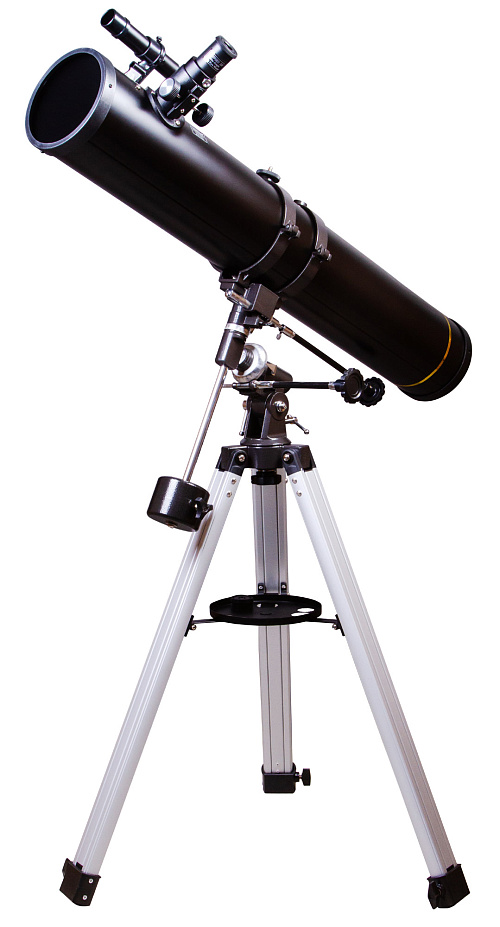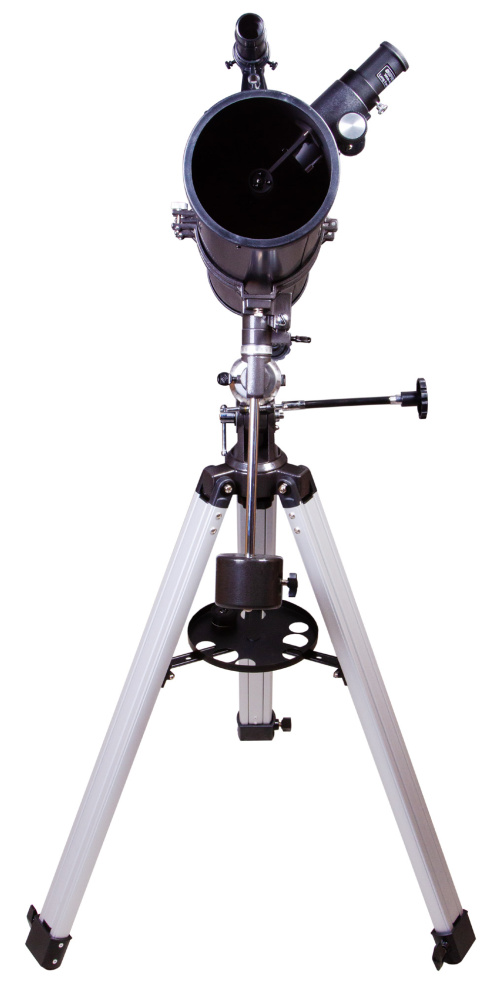Levenhuk Skyline PLUS 120S Telescope
Newtonian reflector. Aperture: 114mm. Focal length: 900mm
| Product ID | 73804 |
| Brand | Levenhuk, Inc., USA |
| Warranty | lifetime |
| EAN | 5905555002224 |
| Package size (LxWxH) | 108x37x24 |
| Shipping Weight | 11.4 |
Levenhuk Skyline PLUS 120S Telescope is a Newtonian reflector with a spherical primary mirror of 114mm diameter. The telescope is suitable for observing the Moon, the planets of the solar system, nebulae, galaxies, star clusters, and many other objects. Due to a large aperture, you can explore the bright objects from the Messier and NGC catalogs. The telescope can view some outer space objects – polar ice caps on Mars, weather changes on Venus, rings of Saturn, satellites of Jupiter, and even distant Uranus and Neptune yet without much detail.
This telescope is suitable for both beginner- and advanced-level astronomers. The equatorial mount allows you to quickly point the telescope at desired objects and track them even during long observations. It takes some time to master the operational process but even an aspiring beginner is unlikely to consider it an issue. The mount is attached to an aluminum tripod; the tripod legs are extendable. An accessory tray is included.
The kit includes all the necessary accessories for observations, and so there is no need to buy any extra tools. There are two eyepieces with different focal lengths and a Barlow lens for adjusting the optimal magnification power for various space objects. An optical finderscope provides 6x magnification.
Features:
- Newtonian reflector on an equatorial mount
- Excellent choice for observing deep space, the Moon, and the planets of the solar system
- Simple and practical tracking of astronomy objects in the sky
- Extensive kit allows for utilizing the optics' capabilities as much as possible
- Stable aluminum tripod with adjustable height
The kit includes:
- Telescope optical tube
- Equatorial mount
- Aluminum tripod with an accessory tray
- 6x24 optical finderscope
- SUPER 10mm (90x) eyepiece
- SUPER 25mm (36x) eyepiece
- 2x Barlow lens
- Slow-motion control knobs
- Counterweight
- User manual and lifetime warranty
| Product ID | 73804 |
| Brand | Levenhuk, Inc., USA |
| Warranty | lifetime |
| EAN | 5905555002224 |
| Package size (LxWxH) | 108x37x24 |
| Shipping Weight | 11.4 |
| Optical design | reflector |
| Optical scheme | Newtonian |
| Optics material | optical glass |
| Optics coating | standard |
| Primary mirror diameter (aperture), mm | 114 |
| Lens (mirror) shape | concave sphere |
| Focal length, mm | 900 |
| Highest practical power, x | 228 |
| Aperture ratio | f/8 |
| Resolution threshold, arcseconds | 1.05 |
| Limiting stellar magnitude | 12.4 |
| Eyepieces | SUPER 10mm (90x), SUPER 25mm (36x) |
| Eyepiece barrel diameter, in | 1.25 |
| Barlow lens | 2x |
| Finderscope | optical, 6x24 |
| Focuser | rack & pinion |
| Tripod | aluminum |
| Tripod height (adjustable), mm | 650–1200 |
| Accessory tray | ✓ |
| Telescope control | manual |
| Mount | equatorial, EQ1 |
| Optical tube mounting mode | fastening rings |
| Optical tube material | metal |
| User level | beginners, experienced users |
| Assembly and installation difficulty level | complicated |
| Observed object | deep-sky objects |
Convenient diagrams that describe how to install additional accessories on refractors and catadioptric telescopes
Find out how to assemble a telescope on an example of the Levenhuk Skyline 90x900 EQ telescope
This short guide will help you avoid typical mistakes and learn more about telescope and mounting types
The basics of astronomical observations for beginners
In this article we have gathered answers to some of the most frequently asked questions about telescopes
The most interesting celestial objects you can observe with Levenhuk telescopes
How telescopes work?
You can actually perform observations from your balcony!
All about telescope sizes, types, magnification, and mounts
Learn how to set up and use the telescope properly
Astronomy in light-polluted skies. Find out what you can observe in the city
Read an interesting comprehensive article on telescopes for little astronomers
The pictures are made with Levenhuk telescopes
Celestial objects you can observe with telescopes of different apertures
Colored and vivid images of galaxies, planets and star clusters entrance everyone who is fascinated by boundless space
Find an interesting review on the history of the changes to a refracting telescope
To make the process of choosing a telescope easier, we will tell you about the characteristics of the most popular types of telescopes today
Learn everything you need to know about refractor telescopes to make the right choice

















